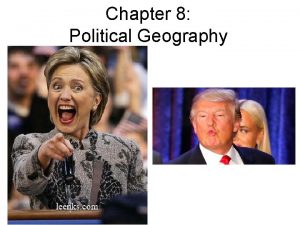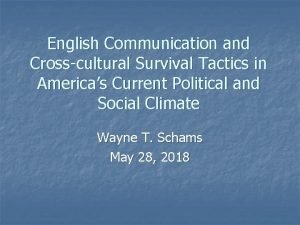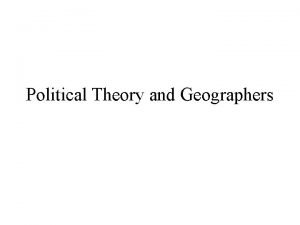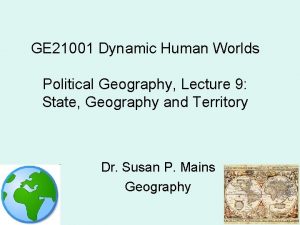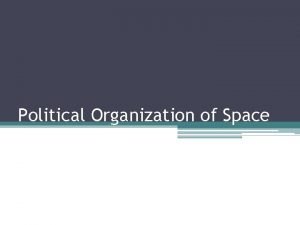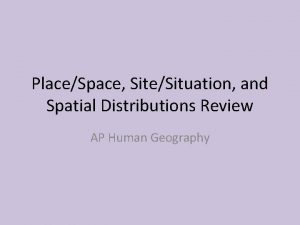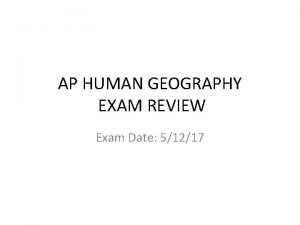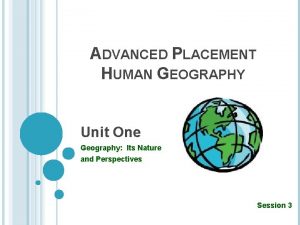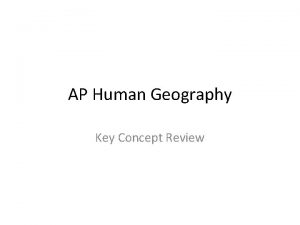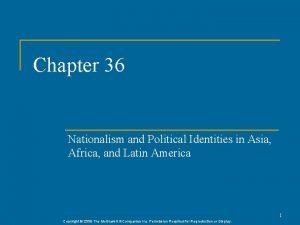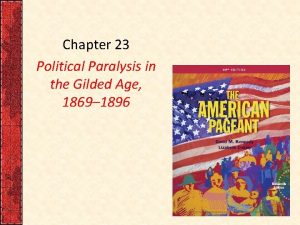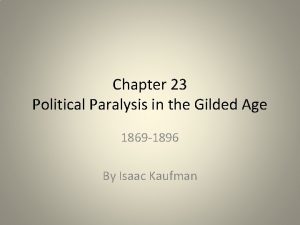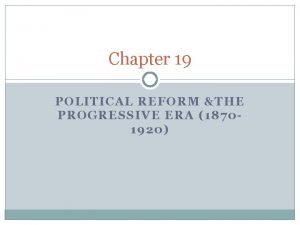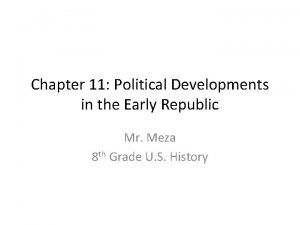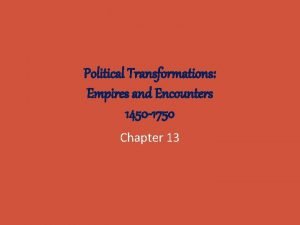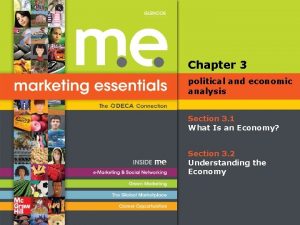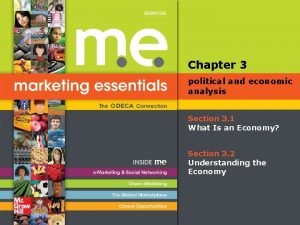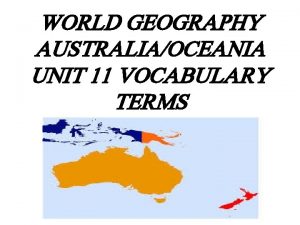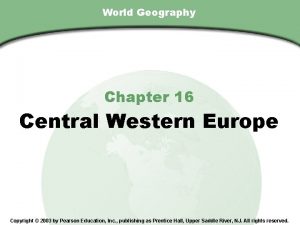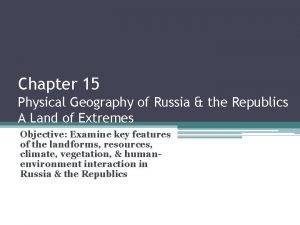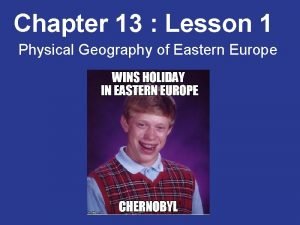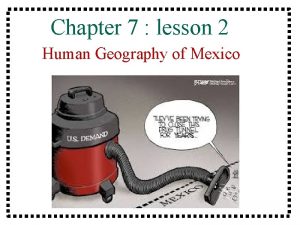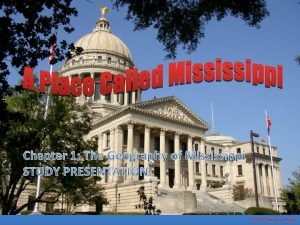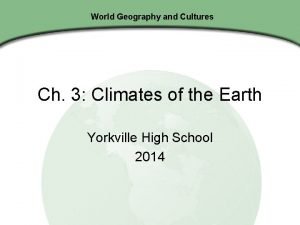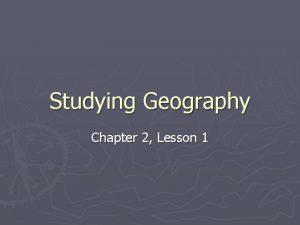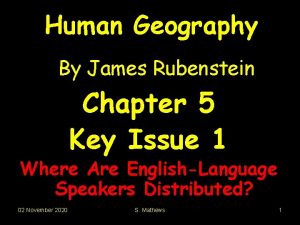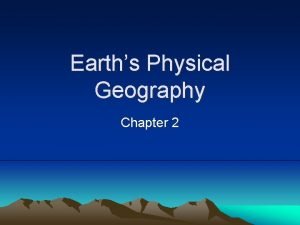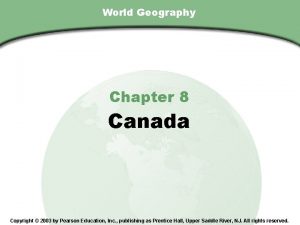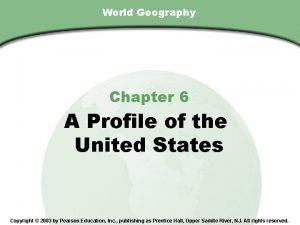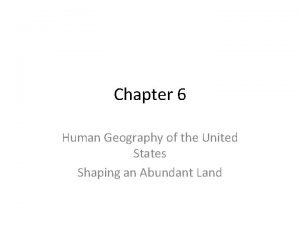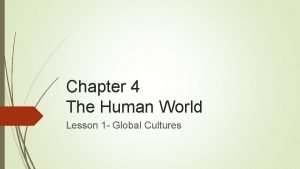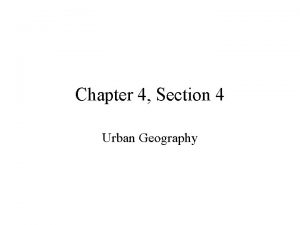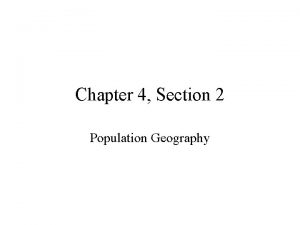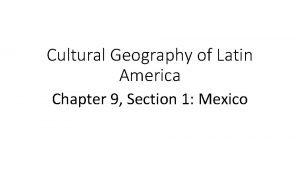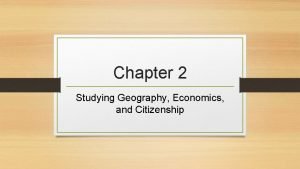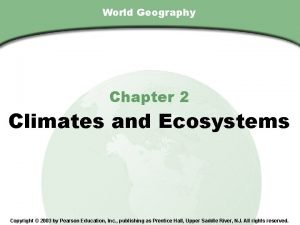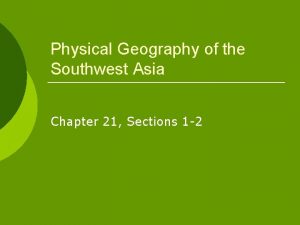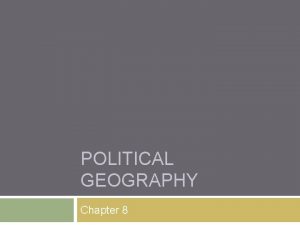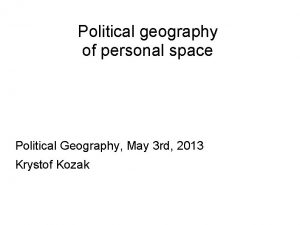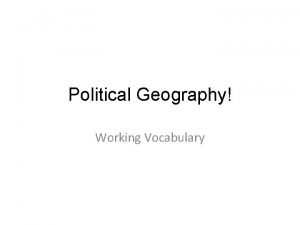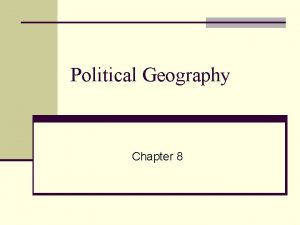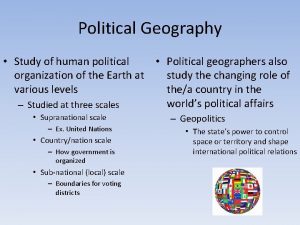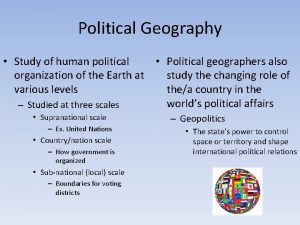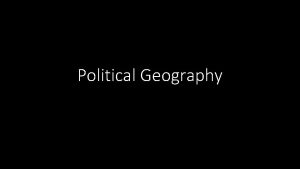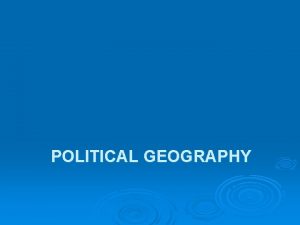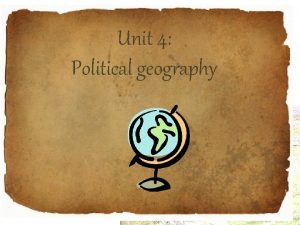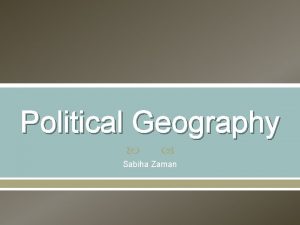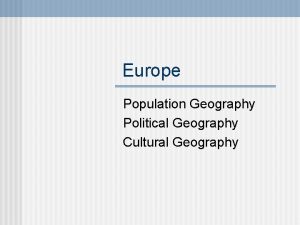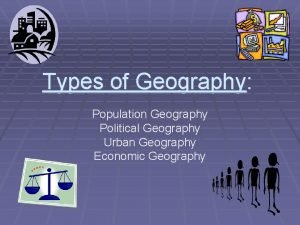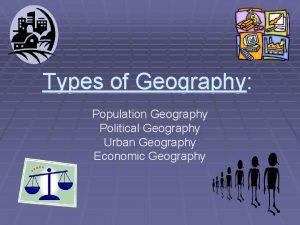POLITICAL GEOGRAPHY Chapter 8 HOW IS SPACE POLITICALLY



































































- Slides: 67

POLITICAL GEOGRAPHY Chapter 8

HOW IS SPACE POLITICALLY ORGANIZED INTO STATES AND NATIONS?

Political Geography – the study of the political organization of the world.

State – a politically organized territory with a permanent population, a defined territory, and a government. To be a state, an entity must be recognized by such by other states.

Nations • Nation – a group of people who share a common cultural heritage, have beliefs and values that help unify them, claim a particular space based on tradition as their homeland, and desire to establish their own state or express self-determination in another way. • People construct nations to make sense of themselves. • Nations are “imagined communities” -Benedict Anderson • imagined = you will never meet all the people in your nation • community = you see yourself as part of it

The Modern State Idea • The Peace of Westphalia • What defined the European continent as territorially defined states • 1648 - came out of years of fighting over religion (Thirty Years’ War) • The idea of a state that is tied to a particular territory with defined boundaries came out of Europe • Diffused through colonialism

The nations we perceive as “natural” and “always existing” are relatively recent phenomena. In 1648, Europe was divided into dozens of small territories.

Nation-States A politically organized area in which nation and state occupy the same space. - Ethnically homogeneous • Where at least 95% of the population in the state is of one ethnicity. • Examples: • Iceland • Japan

Multistate Nation – A nation that lives in more than one state. Hungarians – Most live in Hungary but a lot also live in a region in Romania called Transylvania. Koreans- divided primarily between two states- the Democratic People’s Republic of Korea (North Korea) and the Republic of Korea (South Korea). Many Koreans also live in China and the USA.

Multinational State – A state with more than one nation. - In essence, a state where there is more than one kind of ethnicity comprising the population. The Former Yugoslavia Canada

Stateless Nation – a nation without a state… a group of people without a defined state to live in Kurds- Kurdistan *largest stateless nation* Basques- NE Spain and SW France Palestinians- Gaza Strip and West Bank

Autonomous regions • A defined area within a state that has a high degree of self-government and freedom from its parent state • A state may grant this authority to geographically, ethnically, or culturally distinct areas. • Ex: Aland- group of islands in the Baltic Sea that is part of Finland but lies near Sweden. • Most residents are ethnically Swedish and speak Swedish. • Ex: Canada and the indigenous nations. • Territory of Nunavut, created in 1999. far northern Canada where over 80% of the population consider themselves Inuit.

Enclaves and Exclaves • Vatican City Explained • Countries inside Countries? !? !

Dominant Colonial Influences, 1550 -1950 This map shows the dominant influence, as some places were colonized by more than one power in this time period.

European Colonialism and the Diffusion of the Nation-State Model • Colonialism a physical action in which one state takes over control of another, taking over the government and ruling the territory as its own. Two Waves of European Colonialism: 1500 – 1825 (Americas) 1825 – 1975 (Africa & Asia)

Imperialism & Colonialism Broad concept of ways to influence another country or people Particular type of imperialism where people move into and settle on the land of another country • Early Colonialism • • First wave led by Spain and Portugal, and then by France and Britain Established large empires in the Americas Motivated by “God, gold, and glory” Wanted: economic wealth from exploiting land, labor, and capital, religious influence, and political power • Resulted in the dispossession of indigenous people– “uncivilized land” • Later Colonialism • Led by Great Britain, France, the Netherlands, Belgium, Italy, and Germany • Focused on controlling lands in Africa and Asia • Berlin Conference (aka the Congo Conference) 1884 -1885 split up Africa with no regard to existing ethnic, linguistic, cultural, or political boundaries

Effects of colonization • Colonists resisted the rule of the Europeans, sometimes with violence. • People in the colonies wanted their own economic control over natural resources (ex. Petroleum, precious metals), free elections, and changes in society (ex. Racial equality, religious freedom)

Two Waves of Decolonization First wave – focused on decolonization of the Americas Second wave – focused on decolonization of Africa and Asia

Modern colonialism • Many colonies gained independence politically, but not economically. • Transnational corporations based in the former colonial powers continued to control the extraction of natural resources through mining and the cultivation of agriculture (ex. Coffee, cacao, bananas, etc. ) • New form of colonization, called neocolonialism, emerged in which control over developing countries was exerted through indirect means, whether economic, political, or even cultural power

After effects of decolonization • 1960 -1970 - 32 colonial territories in Africa gained independence. • Independence was won by the colonies and not the cultural groups and the European-made boundaries remained. • As a result, cultural boundaries and political boundaries did not match. • Cultural conflicts within countries led to many civil wars. • Many civil wars spilled over into neighboring countries because cultural groups were not confined. • Ex: Rwandan Genocide in 1994 • Ex: Sudan

HOW ARE BOUNDARIES ESTABLISHED, AND WHY DO BOUNDARY DISPUTES OCCUR?

Boundary – a vertical plane that cuts through the rocks below and the airspace above, dividing one state territory from another.

Boundaries often divide resources, such as oil between Kuwait and Iraq

Establishing Boundaries • Define- usually through a treaty or legal document using the lines of lat. and long. • Delimit- done by cartographers who draw the boundary on a map. • Demarcate- if either party chooses to, they can use a means to visibly mark the boundary on the ground. • Administrate- determine how the boundary will be maintained

• Territoriality – delimiting and asserting control over a geographic area • Sovereignty – having control over a territory • Territorial Integrity – a government has the right to keep the borders and territory of a state intact and free from attack.

Types of Boundaries • Geometric boundaries – based on grid systems and have straight lines no matter the physical landscape. • Ex- Boundary between the US and Canada, western part of US • Weird Border! • Physical boundaries – follow an agreed-upon feature in the physical geographic landscape. • Ex- Boundary between the US and Mexico (wall separating Tijuana and San Diego county)

Types of boundaries • Relict boundary- a former boundary line that is still visible and marked by some cultural landscape. • Ex: Great Wall of China, the Berlin Wall • Antecedent boundary- established before an area is well populated. • Ex: Western border between U. S. and Canada

Types of boundaries • Consequent boundary- established after an area is well populated and respects the existing cultures. • Ex: Boundary between Chile and Argentina, and China and Vietnam • Superimposed boundary- established after an area is populated and ignores cultural and tribal differences across space. • Ex: much of Africa due to Colonization • Berlin Conference 1884 -1885 • Subsequent Boundary – established as the group changes to have different interests Ex: Northern Ireland for dividing for religious reasons

HOW ARE BOUNDARIES ESTABLISHED, AND WHY DO BOUNDARY DISPUTES OCCUR?

Boundary disputes • Definitional dispute- focus on the legal language of the boundary agreement. • Ex: North and South Korea • Locational dispute- center on the delimitation and possibly the demarcation of the boundary. • Ex: Boundary between Saudi Arabia and Yemen is not covered by a treaty and there is oil there • Allocational dispute- involve the allocating of natural resources found along borders • Ex: Netherlands and Germany over natural gas • Ex: Iraq and Kuwait over oil • Operational dispute- involve neighbors who differ over the way their border should function. • Ex: if one country wants to limit migration and the other does not • Ex: trying to stop smuggling across borders

The World Economy Immanuel Wallerstein’s World-Systems Theory: 1. The world economy has one market and a global division of labor. 2. Although the world has multiple states, almost everything takes place within the context of the world economy. 3. The world economy has a three-tier structure.

Construction of the World Economy… 3 C’s Capitalism – people, corporations, and states produce goods and services and exchange them in the world market, with the goal of achieving profit. Commodification – the process of placing a price on a good and then buying, selling, and trading the good. Colonialism – brought the world into the world economy, setting up an interdependent global economy.

Three Tier Structure Core Periphery Processes that incorporate higher levels of education, higher salaries, and more technology * Generate more wealth in the world economy Processes that incorporate lower levels of education, lower salaries, and less technology * Generate less wealth in the world economy Semi-periphery Places where core and periphery processes are both occurring. Places that are exploited by the core but then exploit the periphery. * Serves as a buffer between core and periphery


The Cold War • Period of diplomatic, political, and military rivalry between the USA an the Union of Soviet Socialist Republics (aka USSR/Soviet Union) • Started at the end of WWII in 1945, continued through the collapse of the Berlin Wall in 1989, and ended with the breakup of the Soviet Union in 1991. • USA and SU didn’t fight a direct war… it was fought by a lot of proxy wars in Africa, Latin America, and Asia (attempted influence over newly decolonized areas) • USA- largest conflicts were in Korea, Vietnam, and Afghanistan • Frontline was in Europe • After the defeat of Nazi Germany, Europe divided between East (Communist) and West (Democratic)

The Cold War continued… • Eastern Europe was occupied by the Soviet Army and became Soviet satellite states. • Some states attempted to break away from this control (ex. Hungary in 1956 and Czechoslovakia in 1968) but were unsuccessful. • Germany’s status was perhaps the most complicated. • 1945, Germany was divided into four zones of occupation among the victorious powers (USA, UK, France, SU) • First three zones united to form the Federal Republic of Germany (aka West Germany), which allied with the USA. • The Soviet zone became the German Democratic Republic and allied with the SU. • The split of the country came to head in Berlin, which was actually in Soviet territory but half of the city wanted to join West Germany. • 1961 - a wall, The Berlin Wall, was created to separate the city.

The Cold War continued… • Late 1980 s- SU was under new leadership and began relaxing its grip over its satellite states in Eastern Europe. • 1989 - citizens of both Germany’s brought down the wall that divided them. • Over the next year and a half, Germany had reunited, and former satellite states of Eastern Europe were holding free elections without influence from the SU. • The USSR, made up of 15 republics, began to collapse as well and eventually would become independent countries. • After 1990, with the collapse of communism and the SU, this led to an opportunity for power throughout Europe and the world.

Effects from The Cold War • Many newly independent states • Some peaceful- ex. Czechoslovakia divided into the Czech Republic and the Republic of Slovakia in 1993 • Some very complicated and violent- ex. Breakup of Yugoslavia in 1991 resulting from tensions between Serbs, Bosnians, and others. Many died because of ethnic cleansing. (**Balkanization**) • Changes in the balance of power • NATO (North Atlantic Treaty Organization) formed in 1949 to oppose Soviet military power in Europe. • The balance of economic, political, and military power tilted toward Western Europe and the USA. • This shift frightened the Russians and they reacted by intervening militarily to support any pro-Russian groups in countries like Georgia in 2008, and Ukraine in 2014.

• The world's troubled lands • Interact with lands around the world that are experiencing trouble and/or political chaos • Contested Borders

HOW DO GEOPOLITICS AND CRITICAL GEOPOLITICS HELP US UNDERSTAND THE WORLD?

Geopolitics Politics influenced by geography. All humans are impacted by geography! Two types of geopoliticians: 1. Those who try to explain why certain states are powerful and how to become powerful. 2. Those who try to offer strategic advice for states and explain why countries interact at the global scale the way they do.

Shatterbelt • a region caught between stronger colliding external cultural-political forces, under persistent stress, and often fragmented by aggressive rivals - Usually between different cultures

Choke Point • A strait or canal that could be closed off to stop sea traffic and limit or stop trade. Causes a lot of political tension • https: //www. youtube. com/watch? v=c. UBg 6 Qp_N 98

WHAT ARE SUPRANATIONAL ORGANIZATIONS, AND WHAT IS THE FUTURE OF THE STATE?

Supranational Organizations A separate entity composed of three or more states that forge an association and form an administrative structure for mutual benefit in pursuit of shared goals. * Examples: UN, EU, NATO, NAFTA, ASEAN - The League of Nations was the first attempt at modern Supranationalism… which failed.

Global Scale – The United Nations

The United Nations • Organization created to replace the League of Nations after WWII. • Needed the support of European Nations at the end of WWII. • Peacekeeping efforts around the world • Example: Somalia in the 1990 s. The country was going through social, political, and economic problems which prompted for UN assistance.

Regional Scale – The European Union How does the EU work?

How does Supranationalism affect the State? identities economics

Brexit The United Kingdom (Britain) attempting to leave the EU British + Exit = Brexit


• UNCLOS (United Nations Convention on the Law of the Sea) Law of the Sea • Had to claim by 2011 • Claim territory in the Arctic- Trans. Arctic Shipping boundaries • 12 nautical miles; territorial laws for jurisdiction • 200 for fishing rights and resources Laws governing how to use oceans for government, trade, environment, etc.

ASEAN • Association of Southeast Asian Nations • 10 countries • Peace, Prosperity, Community

HOW DO STATES SPATIALLY ORGANIZE THEIR GOVERNMENTS?

Forces that unite and divide • Centripetal forces- forces that UNITE the people • Aspects: has to do with timing, interaction, perspective, and context. • Examples: Civil Rights Movement, 9/11/01, religion, culture, economy, technology, strong political leaders, war • Centrifugal forces- forces that DIVIDE the people • Aspects: has to do with timing, interaction, perspective, and context. • Examples: war, civil war, racism, political standpoints, religion, culture, economy, laws within the states (death penalty, abortion, gay rights, immigration…)


Forms of Government • Unitary • Federal • highly centralized government where the capital city serves as a focus of power. • a government where the state is organized into territories, which have control over government policies and funds. • Authority held primarily by the central government with little power given to local gov’s • No hierarchy of sovereign powers • Commonly used in areas with few cultural differences and small minorities • Ex: China, Japan, U. K. • Authority of government is shared between the central gov and the provincial, state, and local gov’s • Multiple levels in the hierarchy of power • Commonly used in areas with multiple ethnic groups with significant minorities • Ex: United States, Mexico, Australia, Nigeria, Germany

Nigeria’s Federal Government – Allows states within the state to determine whether to have Shari’a Laws Legal systems based on traditional Islamic laws

The U. S. Federal Government – Allows states within the state to determine “moral” laws such as death penalty, access to alcohol, and concealed weapons. Minnesota’s concealed weapons law requires the posting of signs such as this on buildings that do not allow concealed weapons.

Devolution Movement of power from the central government to regional governments within the state. Many things can cause devolutionary movements: -Ethnocultural reasons: ethnic and/or cultural differences require the state to split into territories - Economic reasons: the state may want to switch their currency and/or let their territories have more power over funds - Spatial reasons: due to too much space and/or being fragmented, a move to being a federal state may be easier

Ethnocultural Devolutionary Movements Balkanization Eastern Europe devolutionary forces since the fall of communism Ethnic and/or cultural reasoning behind the movement of power

Ethnocultural Devolutionary Movements Scotland rise in independence movement is coupled with: - European Union - Scotland’s oil resources

Economic Devolutionary Movements Catalonia, Spain Barcelona is the center of banking and commerce in Spain and the region is much wealthier than the rest of Spain.

Spatial Devolutionary Movements Hawai’i Because of being so far from the U. S. , it is easier for Hawaii to make their own decisions with what the U. S. government gives them instead of D. C. trying to control what goes on there.

HOW DO STATES SPATIALLY ORGANIZE THEIR GOVERNMENTS?

Electoral Geography • A state’s electoral system is part of its spatial organization of government. In the United States: - territorial representation - reapportionment- redrawing the district lines - voting rights for minority populations - census every 10 years to reset proportional representation in the House of Rep’s and then to redraw district boundaries if necessary.

Gerrymandering – drawing voting districts to benefit one group over another. Majority-Minority districts drawn so that the majority of the population in the district is from the minority. Gerrymandering Explained
 Example of a superimposed boundary
Example of a superimposed boundary Politically correct term for disabled
Politically correct term for disabled Ap human geography frq examples
Ap human geography frq examples Stateless nation
Stateless nation Classification of boundaries in political geography
Classification of boundaries in political geography Objective of political geography
Objective of political geography Mariana trench
Mariana trench Relationship between political science and geography
Relationship between political science and geography Contemporary political map
Contemporary political map Nafta definition ap human geography
Nafta definition ap human geography Compare geometric boundaries and antecedent boundaries.
Compare geometric boundaries and antecedent boundaries. Political geography
Political geography Centripetal force vs centrifugal
Centripetal force vs centrifugal Political organization of space definition
Political organization of space definition Geri flanary
Geri flanary 5 themes of geography ap human geography
5 themes of geography ap human geography Time space convergence definition ap human geography
Time space convergence definition ap human geography Borchert model ap human geography
Borchert model ap human geography Popular culture example
Popular culture example Time space compression ap human geography
Time space compression ap human geography Space-time prism ap human geography
Space-time prism ap human geography Cartesian space trajectory planning
Cartesian space trajectory planning Space junk the space age began
Space junk the space age began Camera space to world space
Camera space to world space Unscented trajectory chapter 5
Unscented trajectory chapter 5 Ndc to screen space
Ndc to screen space Chapter 35 nationalism and political identities in asia
Chapter 35 nationalism and political identities in asia Chapter 36 nationalism and political identities in asia
Chapter 36 nationalism and political identities in asia Chapter 23 political paralysis in the gilded age
Chapter 23 political paralysis in the gilded age Chapter 23: political paralysis in the gilded age
Chapter 23: political paralysis in the gilded age Chapter 19 political reform and the progressive era
Chapter 19 political reform and the progressive era Chapter 11 political developments in the early republic
Chapter 11 political developments in the early republic Chapter 5 political transformations empires and encounters
Chapter 5 political transformations empires and encounters Chapter 3 political and economic analysis
Chapter 3 political and economic analysis Chapter 3 political and economic analysis
Chapter 3 political and economic analysis Chapter 23 political paralysis in the gilded age
Chapter 23 political paralysis in the gilded age Ap human geography chapter 11 vocab
Ap human geography chapter 11 vocab Chapter 16 a diverse heritage
Chapter 16 a diverse heritage The cultural geography of europe chapter 12 answer key
The cultural geography of europe chapter 12 answer key Chapter 27 physical geography of east asia
Chapter 27 physical geography of east asia Chapter 22 human geography of southwest asia
Chapter 22 human geography of southwest asia World geography chapter 16 section 1
World geography chapter 16 section 1 Chapter 15 physical geography of russia and the republics
Chapter 15 physical geography of russia and the republics Lesson 1 physical geography of southeast asia
Lesson 1 physical geography of southeast asia Definition of eastern europe
Definition of eastern europe Chapter 11 ap human geography
Chapter 11 ap human geography Chapter 15 cultural geography of russia answer key
Chapter 15 cultural geography of russia answer key Chapter 7 lesson 2 human geography of mexico
Chapter 7 lesson 2 human geography of mexico Lingua franca ap human geography definition
Lingua franca ap human geography definition Chapter 13 human geography of europe
Chapter 13 human geography of europe Which city is located in the north central hills region?
Which city is located in the north central hills region? World geography chapter 3 climates of the earth
World geography chapter 3 climates of the earth Lesson 1 studying geography
Lesson 1 studying geography Received pronunciation definition ap human geography
Received pronunciation definition ap human geography World geography chapter 3 weather and climate
World geography chapter 3 weather and climate Earth's physical geography chapter 2
Earth's physical geography chapter 2 World geography chapter 8 section 1
World geography chapter 8 section 1 World geography chapter 6 section 1
World geography chapter 6 section 1 Chapter 6 human geography of the united states
Chapter 6 human geography of the united states Chapter 5 lesson 1 physical geography of the united states
Chapter 5 lesson 1 physical geography of the united states Chapter 4 lesson 5 urban geography
Chapter 4 lesson 5 urban geography Exurb ap human geography
Exurb ap human geography Chapter 4 section 2 population geography
Chapter 4 section 2 population geography Chapter 9 cultural geography of latin america answers
Chapter 9 cultural geography of latin america answers Chapter 2 lesson 1 studying geography
Chapter 2 lesson 1 studying geography World geography chapter 2 review answers
World geography chapter 2 review answers Chapter 8: the physical geography of latin america answers
Chapter 8: the physical geography of latin america answers Map of southwest asia
Map of southwest asia
